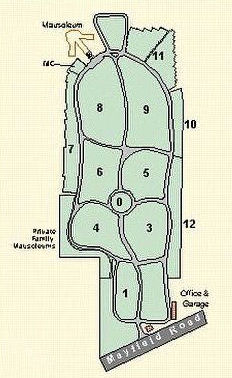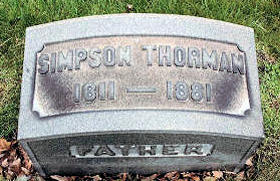|
Mayfield
Cemetery - 1887 10,500 burials

|
In 1887, when
the trustees of Tifereth Israel bought the land
for Mayfield Cemetery, Cleveland's Jews lived
between East 9th and East 55th streets. The
cemetery was about a mile east of the city
limits which were near East 110th Street, and up
a steep hill - Mayfield Road. But it was next to
200-acre Lake View Cemetery, the final resting
place of Cleveland's elite, and on a state road.
They chose well. MapQuest map.
|
|
It is owned by United Jewish
Cemeteries, which is jointly owned by
Cleveland's oldest congregations: Anshe
Chesed Fairmount Temple and The Temple -
Tifereth Israel.
In this Google Satellite View ®
north is at the top, east at the right. Mayfield
Road, which runs east-north-east, is in the
lower right. Coventry Road, which runs
north-south, is at the right.
A chapel and a building for the
office and caretaker were soon constructed. A
mausoleum was added in 1930 and enlarged in
1970.
Rabbi Abba Hillel Silver's gravesite is in
the southwest (lower left) corner, marked on
this image by a small gold circle.
The
grave of Moses Alsbacher is in section 4. |
|
 |
|

from website of
United Jewish Cemeteries |
In 1887 Tifereth Israel (today The Temple - Tifereth
Israel) was on Huron Road and East 6th and their
cemetery was only a half acre west of the
Cuyahoga River, next to the
Anshe Chesed's
Willet
Street Cemetery. But a trend as old as
Cleveland - the better-established residents
moving east to newer housing - was accelerating as
immigrants poured in to the low cost housing in
the old Lower Woodland neighborhoods.
Tifereth Israel would soon buy land for a new
synagogue on Willson Avenue (East 55th). Looking far
ahead, they bought more than 22 acres of
land for a
cemetery on Mayfield Road, a mile beyond the city's
eastern border.
The property was then in East Cleveland Township.
Today it is in the city of Cleveland Heights. The hamlet of Cleveland Heights would be created in
1901, incorporated as a village in 1903, and as a
city in 1921.
We show below a
segment of an 1898 map of East Cleveland Township,
showing Lake View Cemetery and a "Jewish Cemetery"
section,
where Mayfield Cemetery is today. The map wrongly suggests
that Mayfield Cemetery was a section of Lake View.
Mayfield Cemetery's property does abut Lake View and
it gives the appearance of being part of Lake View.
But from the start, Mayfield Cemetery was always a separate
entity.

From an 1898 map of East Cleveland
Township Cleveland Public Library Digital
Collection
Why the need for
more burial space?
In 1886 Tifereth
Israel had only 128 families. Each death is recorded
in the congregations minutes, as are burial fees.
With the congregation losing perhaps 10 persons a
year, why the need for so much more space?
The Jewish community
was growing older and the older generation would
have been thinking in terms of family plots.
Families then were large. Simson and Regina Thurman
had ten children; the norm was perhaps four or five
children. Thus, it would be the sale of family plots
that created the demand. Members would have
wanted burial in a Jewish cemetery and not one of
the small cemeteries owned by Orthodox
congregations.
The timeline
A careful reading of
the minutes of Tifereth Israel show these steps.
Almost all the land
that today is Mayfield Cemetery was one holding of
more than 20 acres. Three transactions were
involved:
|
October 17,
1886
More land is
purchased adjacent to the Willet Street Cemetery
for $600.
July 31, 1887
At a special
meeting of the Tifereth Israel trustees a
resolution to buy 20 acres of land at $300 an
acre is passed by a vote of 25 to 1.
August 3, 1887
Jacob Mandelbaum buys the 20.649 acre parcel
from Sarah and Daniel Doty. The price of $300 an
acre seems high for that location, but the size
of the property, its location on a state road
(now Mayfield Road) and its being adjacent to
200-acre Lake View Cemetery, where Cleveland's
leading non-Jewish families are buying plots,
made it very desirable. An 1873 map of Cleveland
shows a streetcar line on Euclid Avenue (it ran
on Prospect Avenue until East 40th to avoid the
street of mansions (Millionaire's Row), all the
way to Lakeview Avenue.
September 3,
1887
Jacob Mandelbaum and his wife (wives were often
included in deeds to resolve any claims of dower
right) sold the land to Tifereth Israel for
exactly what they had paid.
June 3, 1890
The first burial, Samuel Bloch, age 36.
October 8, 1890
The two congregations vote to merge their
cemeteries, forming
United Jewish Cemeteries. This joint control continues today.
May 30, 1893
(Decoration Day)
The chapel, an octagonal stone structure seating
200 persons is dedicated.
|
See the
Mayfield Cemetery deeds.
For more, see our page on
United Jewish Cemeteries.
|
As Mayfield Cemetery was developed, some
families reinterred their relatives there from Willet
Street Cemetery. One example: Cleveland's first
Jewish settler
Simpson Thorman.
Simpson Thorman's headstone in Mayfield Cemetery
photo Wendy Lang
In addition to the regular streetcar service up
Mayfield Road, for many years a special
funeral streetcar
would bring mourners and the casket up Mayfield Road to
the cemeteries and after the funeral, take the
mourners
back to town. |
|
 |
1928 - Mayfield
Cemetery becomes restricted to congregation members
Originally open to all Jews, Mayfield Cemetery would
change its rules in 1928. Following a custom often
practiced in older congregations in Cleveland and
elsewhere, burials would now be
limited to members in good standing of these two Reform
congregations.
|
Why this restriction and why in 1928?
In 1890 the two congregations had a total membership of less
than 400 families. But the great wave of immigration (1880-1924) would cause Cleveland's Jewish population to soar - from 3,500
in 1880 to 85,000 in 1925. Many new congregations, first Orthodox, then Conservative, would form. Yet
for 97 years (1851 - 1947) no new Reform congregations would
be started!
With some immigrants and so many of their
children joining Reform congregations, by the mid-1920s Silver's (Tifereth Israel) and Brickner's (Anshe
Chesed) as many called them - were among the nation's largest, with a combined membership of more than
4,000 families. While in the early years the cemetery would have been seen as more space
than they would ever need, by 1928 it is
understandable that the congregations would
conclude that it was not large enough to
accommodate nonmembers. Further, this policy also
means that members who resign or do not pay
their dues cannot be buried in their old family
plots. |
Learn more on these
pages
Links to other
sources
|
Thanks to Pat Corrigan
This first version of
this web page, with the 1898 map (above)
showing Mayfield Cemetery within Lake View Cemetery and finding no deeds
in 1887 - 1890 for Tifereth Israel or
United Jewish Cemeteries, stated that Mayfield
Cemetery had bought the
right to use the section for burials, but did
not own
the land. (Such arrangements are found when
congregation takes control of a section of a
larger cemetery.) We invited Pat Corrigan, the
director of Mayfield Cemetery, to review the
page. He replied that we had it
wrong: the land was owned by United
Jewish Cemeteries and not by Lake View Cemetery.
When he said "Look for Jacob Mandelbaum." we soon found the
deeds and corrected our error. Thank you Pat. |
|